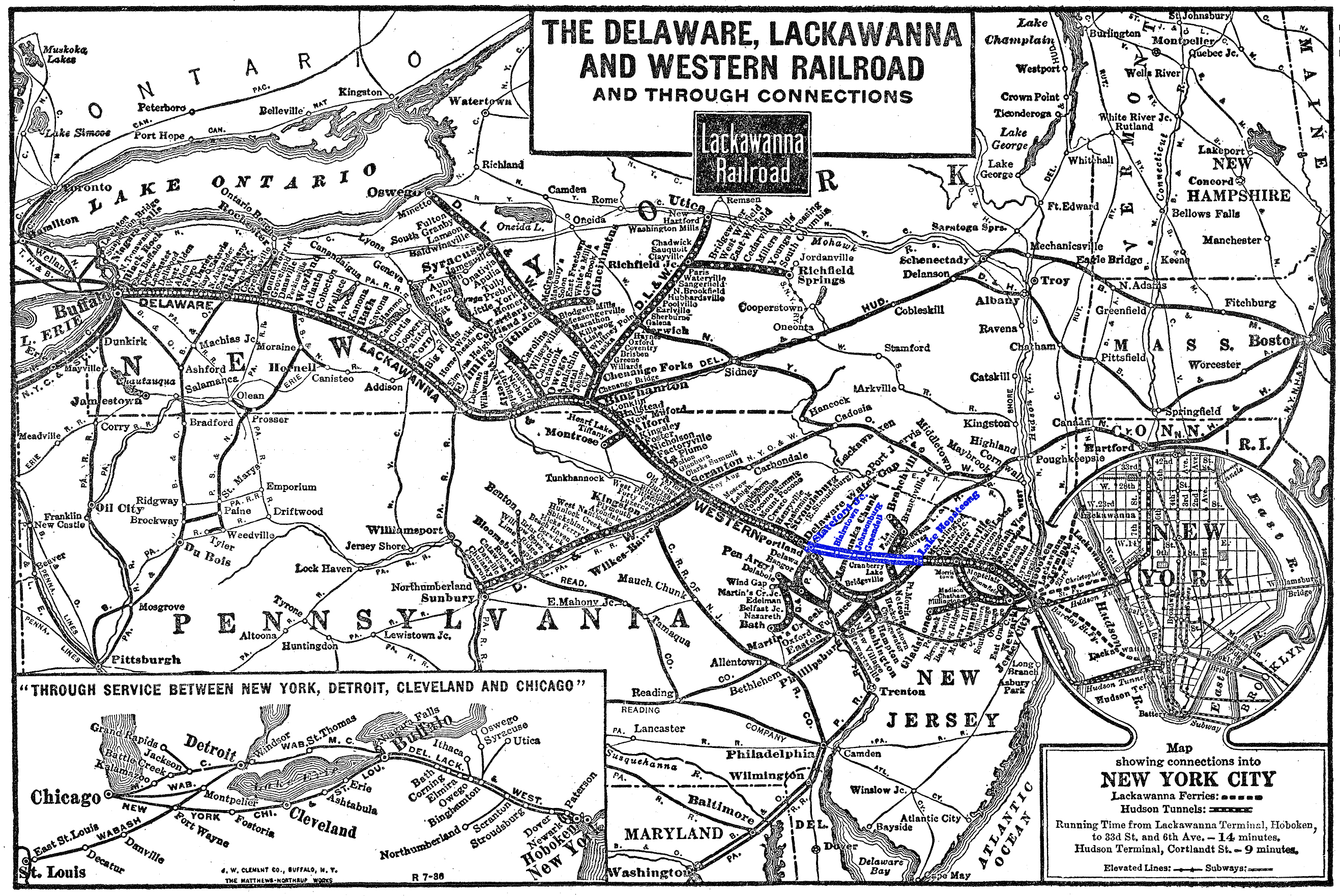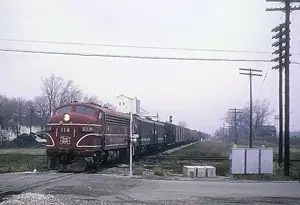Lackawanna Cutoff: Map, Progress, Restoration
Last revised: August 24, 2024
By: Adam Burns
The Lackawanna Cutoff is a historic rail line in New Jersey and Pennsylvania, originally built by the Delaware, Lackawanna & Western Railroad (DL&W) in the early 20th century.
It as one of two grand realignment projects carried out by the Lackawanna in the very early 20th century. Known for its high-speed, low-grade route, it was a significant engineering achievement, featuring large cuts, fills, and tunnels.
Working from east to west the Cutoff was built between 1908 and 1911 at a cost of $11 million. While the route was only 28.5 miles in length it eliminated more than 11 miles redundant trackage, many sharp curves, and reduced the ruling grade by more than half.
The cutoff only remained in use for 73 years before its abandonment and removal by Conrail in 1984. In the proceeding years there have been many attempts to reactive the cutoff, predominantely for passenger and commuter service.
There are few other rail corridors in such rugged terrain that offer such a superb right-of-way with few grades or curves. The property is currently owned by NJ Transit with eventual plans to restore the route to operation as a high speed commuter line.
In 2023 those plans are much closer to becoming reality when the commuter system announced plans in April to overhaul Roseville Tunnel for $32.5 million.
Photos
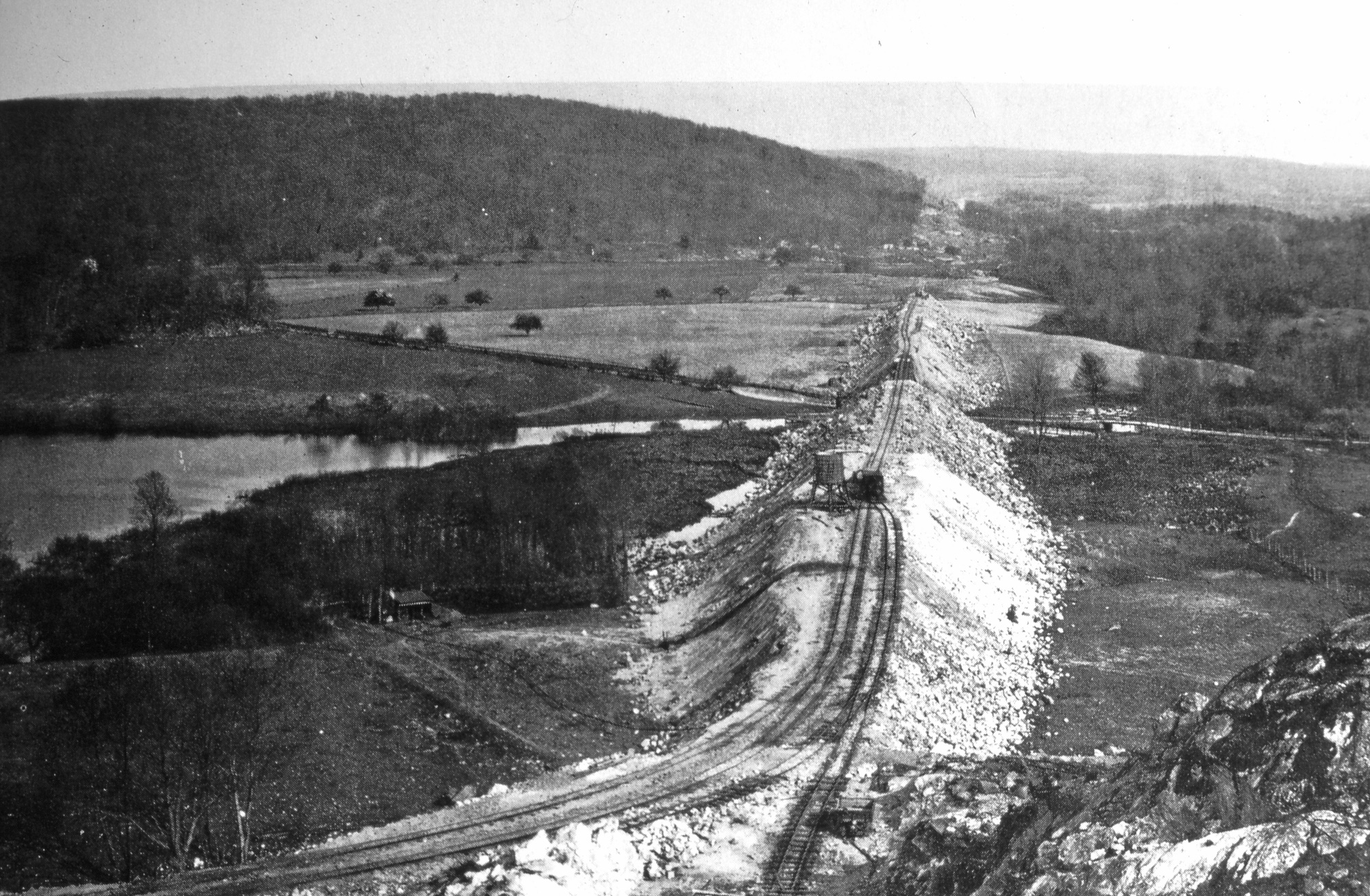 Constructing the Lackawanna Cutoff, seen here in an eastward view of Wharton Fill from the top of Roseville Tunnel in May of 1909.
Constructing the Lackawanna Cutoff, seen here in an eastward view of Wharton Fill from the top of Roseville Tunnel in May of 1909.History
The Delaware, Lackawanna & Western was one of the Northeast's most success anthracite coal lines. Its heritage can be traced back to two predecessors; the Liggetts Gap Railroad, incorporated on April 7, 1832 and the Delaware & Cobbs Gap Railroad, chartered on December 4, 1850.
The DL&W gained its name in March, 1853 when it merged with the Delaware & Cobbs Gap to form the Delaware, Lackawanna & Western.
At its peak, the DL&W operated 950 miles between Hoboken, New Jersey and Buffalo running via Scranton, Binghamton, and Elmira. The railroad also operated notable branches to Northumberland/Sunbury, Oswego, and Utica.
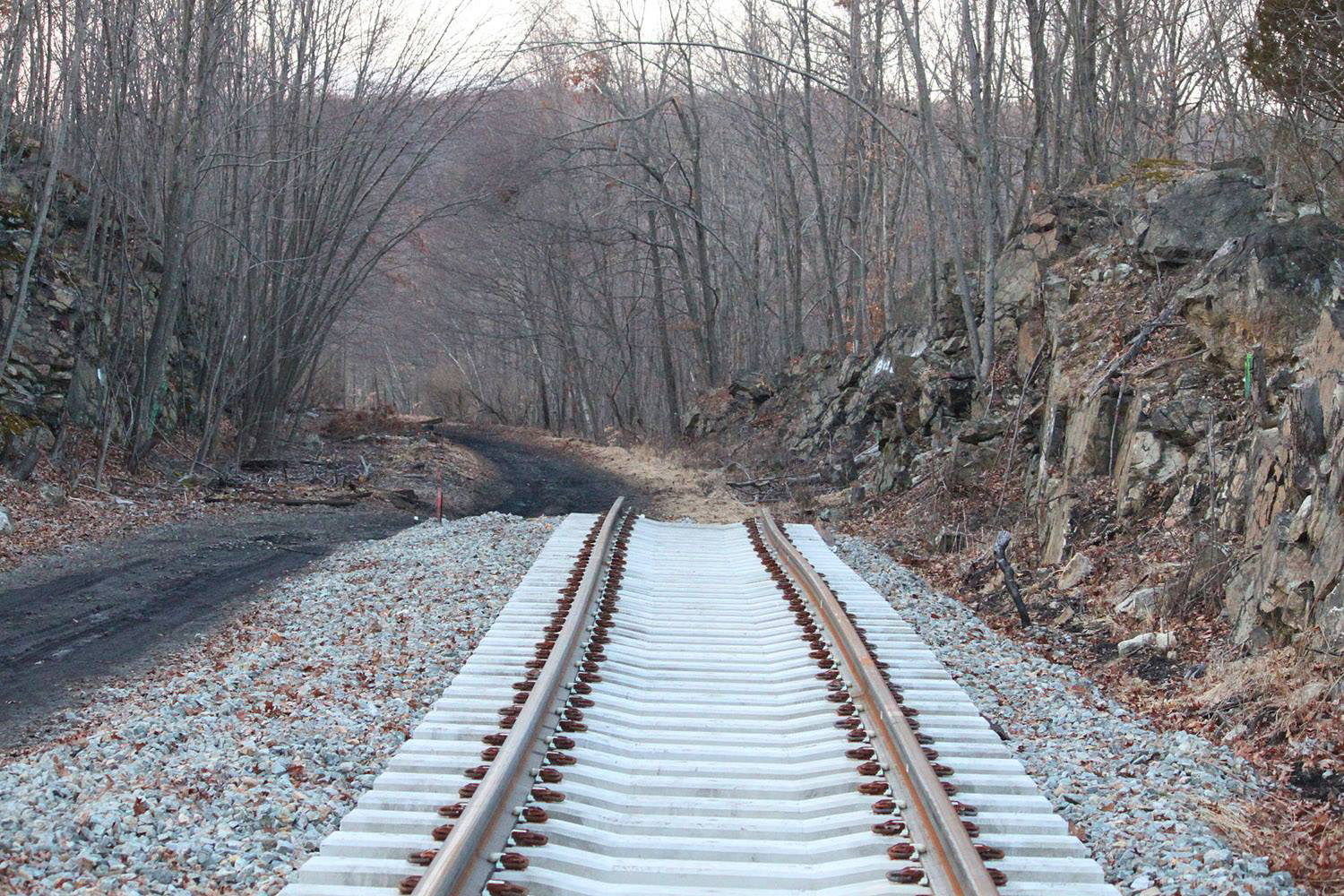 The current end-of-track at Lake Lackawanna, located about 4 1/4-miles west of Port Morris. The state of New Jersey is rebuilding the Lackawanna Cutoff to serve New York City-bound commuters. The line will be operated by NJ Transit.
The current end-of-track at Lake Lackawanna, located about 4 1/4-miles west of Port Morris. The state of New Jersey is rebuilding the Lackawanna Cutoff to serve New York City-bound commuters. The line will be operated by NJ Transit.Construction
Throughout most of its corporate existence, until the 1950s, was a very profitable and well-managed company thanks to the many lucrative anthracite coal mines it served. It also handled significant timber business and transported a great deal of vacationers to and from New York's many resorts in the Pocono Mountains.
Its profitabilty was never greater than at the turn of the 20th century. With the railroad overflowing in cash, William Haynes Truesdale, who became president of the DL&W on March 2, 1899, sought immediate improvements to the 950 mile railroad to increase the road's freight capacity.
He also wanted the railroad to be more competitive in the New York/New Jersey-Buffalo market in addition to alleviating a circuitous route throughout much of western New Jersey and eastern/northeastern Pennsylvania that slowed trains to only 50 mph.
To carry out the project the railroad elected to use reinforced concrete throughout , a relatively new material for that time.
The idea of the DL&W leveling and straightening its main line to Buffalo began around 1900 and was the result of its president William Haynes Truesdale,
What became known as the Lackawanna Cutoff, it was the railroad's first significant improvement project of the early 1900s.
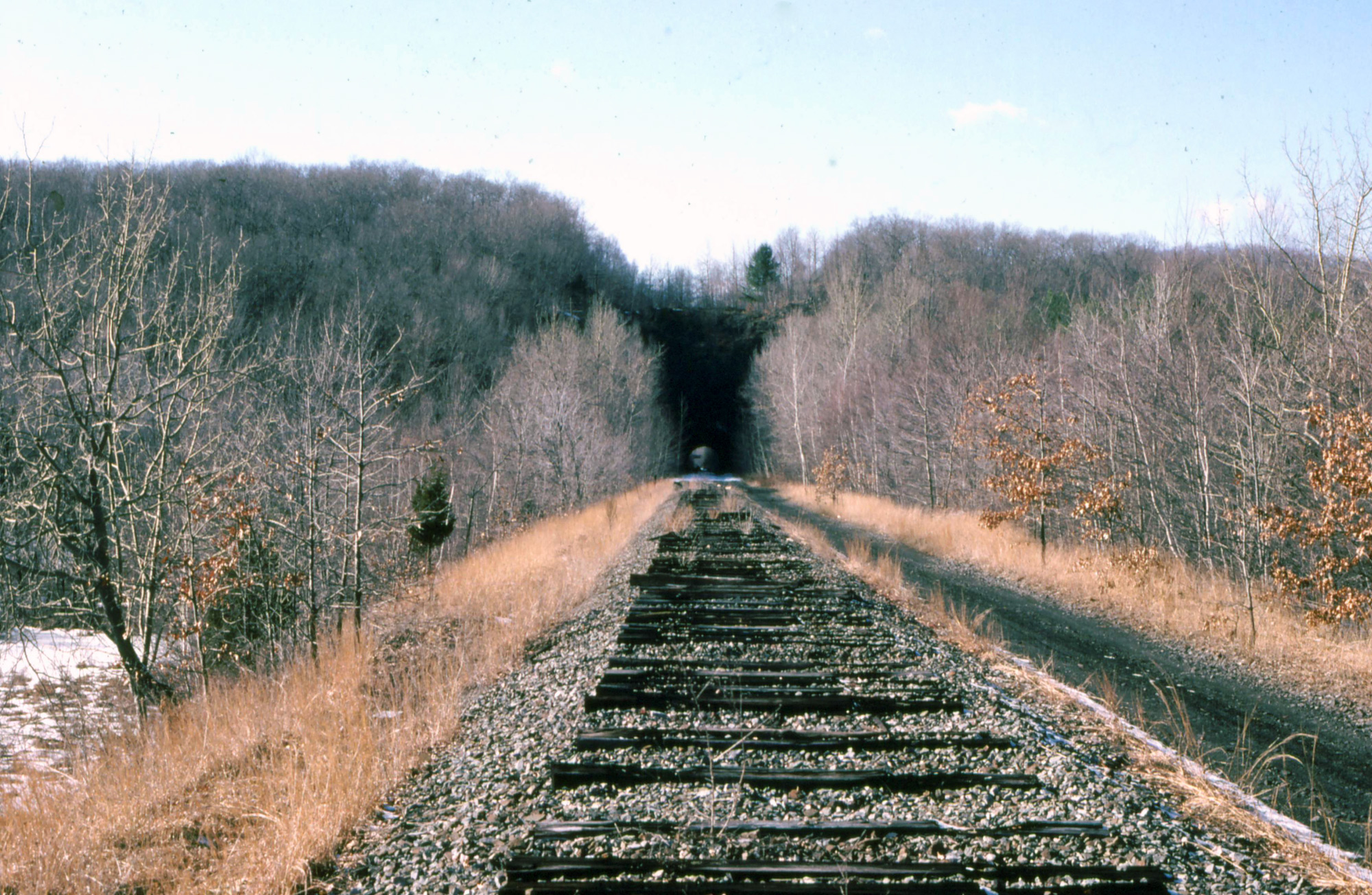 Following the abandonment of the Lackawanna Cutoff, looking towards Roseville Tunnel in the fall of 1989 about a decade after Conrail stopped using the corridor.
Following the abandonment of the Lackawanna Cutoff, looking towards Roseville Tunnel in the fall of 1989 about a decade after Conrail stopped using the corridor.The new alignment, which replaced the "Old Road" broke away from the main line initially heading north, then west from Port Morris, New Jersey (Lake Hopatcong).
The DL&W spared no expense in straightening and leveling its main line using massive fills and deep cuts to keep the maximum ruling grade at an astounding 0.55%! Perhaps the Cutoff's most impressive feature was its bridges, which are arched designs built of reinforced concrete.
Most notable of these is Paulinskill Viaduct, one of the largest in the world at the time before Tunkhannock Viaduct was built. The bridge spans Paulins Kill in New Jersey and is more than 1,000 feet long and 100 feet high.
Map (1930)
Operation
The DL&W served many concrete plants along its network. Since it was so readily available it was an easy decision to incorporate the material into the cutoff's construction. It was also prodigously utilized on the later Nicholson-Hallstead Cutoff.
The DL&W built almost everything from concrete, from bridges and tunnels to interlocking towers, stations, and other lineside structures.
The cutoff ultimately opened for business, officially, on December 24, 1911 at a cost of more than $11 million. With no grade crossings, curves, and a ruling grade of 0.55%, the 28.45-mile double-tracked cutoff allowed trains to operate at speeds of 80 mph.
The investment underscored the company's deep commitment to revolutionizing transportation and commerce during that period. In additoin, the state-of-the-art rail line was opened to wide acclaim and heralded a new epoch of innovation in the realm of railroads and transportation.
The innovative use of reinforced concrete for the construction of bridges and viaducts marked the Cutoff as a trailblazer. This pioneering engineering choice significantly increased the infrastructure’s durability and resilience, ensuring the Cutoff remained unscathed even after a century of its initiation.
The Cutoff's peak years of operation were arguably from the 1920s through to the late 1940s. During these decades, the Cutoff ferried millions of tons of freight and countless passengers with remarkable efficiency and speed.
Abandonment
The cutoff remained in use through the DL&W and Erie Lackawanna (1960) eras. Passenger service on the line ended in 1971 and most of the remaining freight trains had been transferred to the former Erie main line after the EL merger.
Interestingly, the decision to transfer trains off the corridor was largely one of opposing management styles. When the Erie Lackawanna merger occurred in 1960, most of the company's top officials came over from the Erie while DL&W's management team was given few notable leadership roles.
By the time Conrail assumed control of the route (April 1, 1976) virtually no online traffic remained and the railroad made plans to abandon the route, despite its level grade. In 1984 the rails were pulled although an effort to preserve the right-of-way for future commuter use in 1989 saved it from an uncertain future.
Over the past few decades, however, interest in the Lackawanna Cutoff has seen a resurgence. Multiple campaigns and movements have rallied to restore this historical symbol, resituating it within contemporary discourses of transportation and historical preservation.
Since that time, both Pennsylvania and New Jersey have slowly worked to complete the necessary paperwork to begin the line's reconstruction. This effort culminated with the reconstruction of the first 7.3 miles between Andover and Port Morris Junction, New Jersey in 2013.
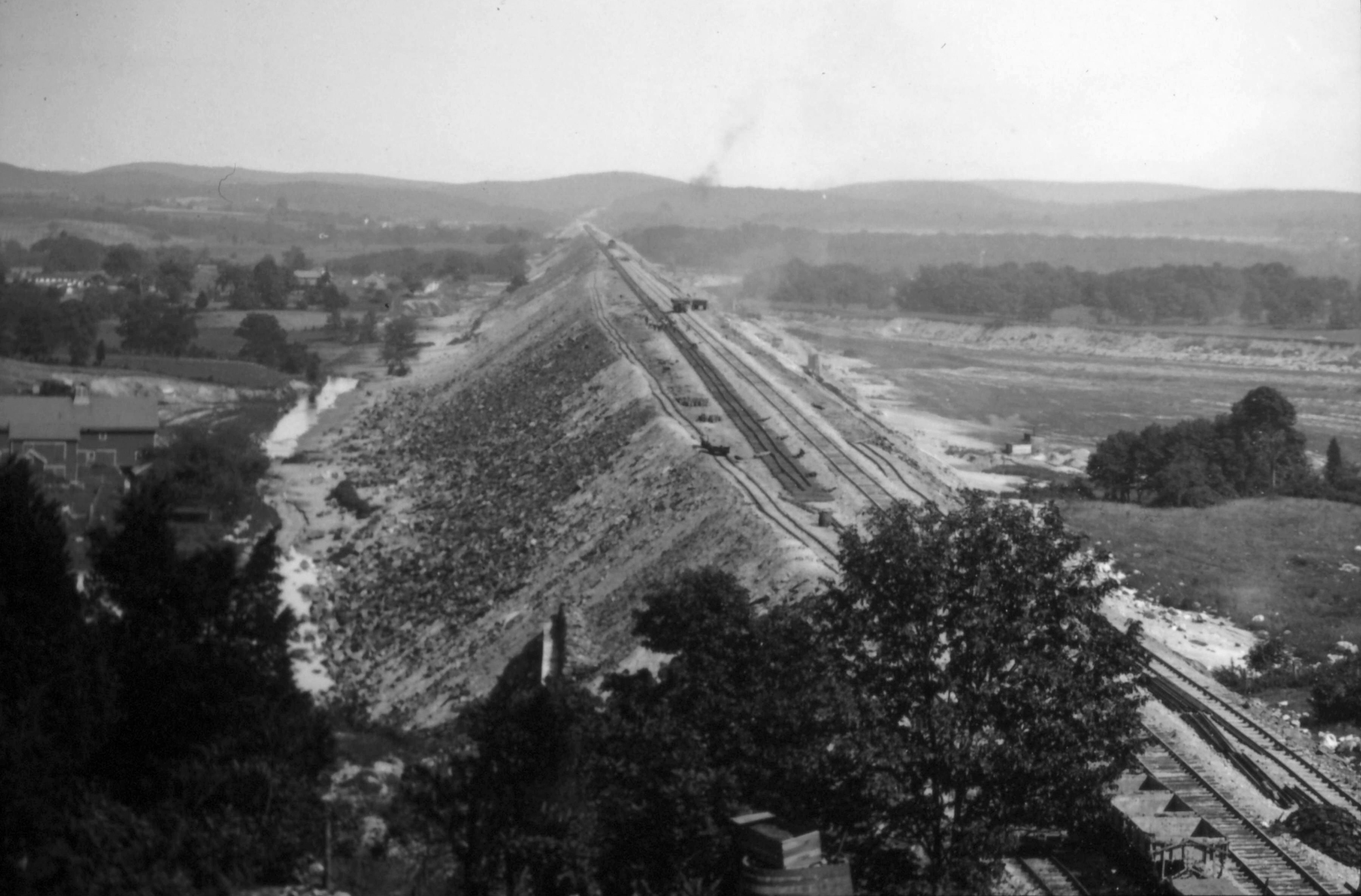 Seen here is the massive Pequest Fill under construction, near Tranquility, New Jersey in the summer of 1911.
Seen here is the massive Pequest Fill under construction, near Tranquility, New Jersey in the summer of 1911.2022 Restoration
Following almost another decade of little activity, in an announcement made public in April, 2022 NJ Transit stated that it plannned to invested $32.5 million in repairing and overhauling the 1,024-foot Roseville Tunnel between Port Morris and Andover.
The project is part of a larger effort for NJ Transit and Amtrak to finally expand passenger service directly to Scranton, Pennsylvania.
To do so, the Lackawanna Cutoff (Port Morris - Slateford Junction, Pennsylvania) must be restored, which can then utilize short line Delaware-Lackawanna Railroad's trackage (ex-Lackawanna) into Scranton.
This is the closest the famous cutoff has been yet to finally seeing trains return after nearly 40 years of silence. It appears with the tunnel's restoration it will finally become reality.
Overall, the Lackawanna Cutoff is much more than just a stretch of railroad. It is a living testament to a bygone era of innovation, determination and engineering prowess, embedding deep in the heart of the American railroad narrative. With current efforts to restore the line, the future may yet see the rebirth of this grand piece of history.
Recent Articles
-
Kankakee Belt Route, NYC's Illinois Division
Dec 08, 25 12:25 AM
The Kankakee Belt Route was one of the Midwest’s most interesting “quiet” main lines—a strategic bypass around Chicago that never became a famous name in its own right. -
Oregon Christmas Train Rides In Sumpter!
Dec 07, 25 11:37 PM
Among the Sumpter Valley Railroad's most popular offerings each year are the Christmas Trains, beloved family outings that blend history, holiday cheer, and vintage railroading in an unforgettable way… -
Ohio Polar Express Train Rides In Dennison!
Dec 07, 25 11:24 PM
Tucked into the small town of Dennison in eastern Ohio, the Dennison Railroad Depot Museum preserves a remarkable slice of American history while delivering one of the region’s most beloved holiday tr…

